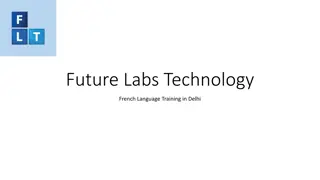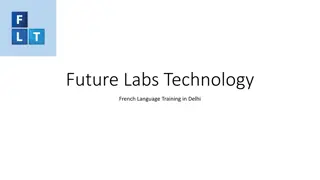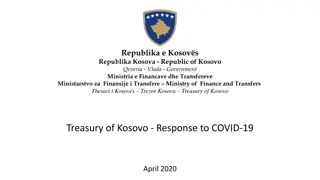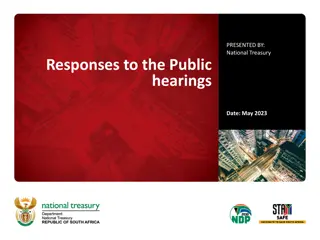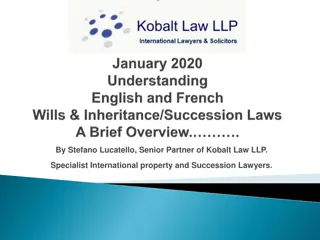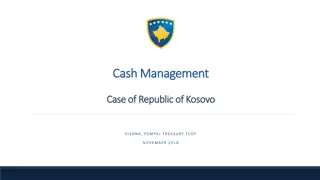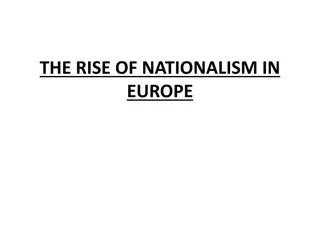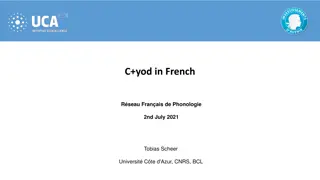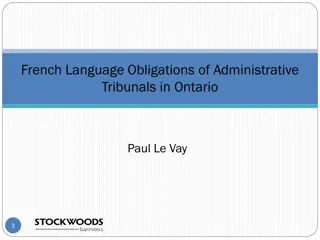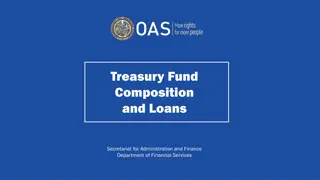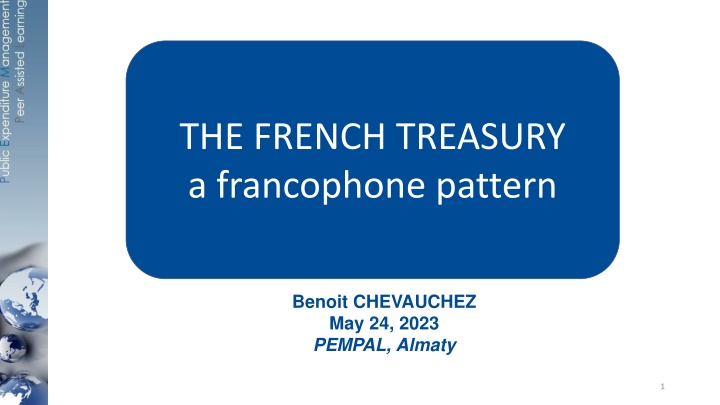
French Treasury Merger and Financial Reforms
Explore the evolution of the French Treasury, the merger of tax collection agencies in 2008, and the shift towards decentralized public finances. Learn about the challenges, achievements, and control methods in the francophone PFM landscape. Dive into the organizational structure of the DGFIP and key features of the French fiscal administration.
Download Presentation

Please find below an Image/Link to download the presentation.
The content on the website is provided AS IS for your information and personal use only. It may not be sold, licensed, or shared on other websites without obtaining consent from the author. If you encounter any issues during the download, it is possible that the publisher has removed the file from their server.
You are allowed to download the files provided on this website for personal or commercial use, subject to the condition that they are used lawfully. All files are the property of their respective owners.
The content on the website is provided AS IS for your information and personal use only. It may not be sold, licensed, or shared on other websites without obtaining consent from the author.
E N D
Presentation Transcript
THE FRENCH TREASURY a francophone pattern Benoit CHEVAUCHEZ May 24, 2023 PEMPAL, Almaty 1
1. GENERAL INTRODUCTION 2. The TREASURY 3. FRANCOPHONE PFM FEATURES 4. RECENT ACHIEVEMENTS AND CHALLENGES 5. NEW CONTROL APPROACHES AND METHODS 6. LESSONS AND CONCLUSIONS 2
FRANCE FRANCE 68 million inhabitants, 550 000 km2 1. Centralised tradition, mitigated by decentralisation reforms since 1983 13 regions 104 departments 35 000 communes 2. A heavily fiscalised country Tax/GDP 45% Spending/GDP 56% Debt/GDP 110% 3. General government= 1520 billion Central government 39 % Local government 18 % Social Security 43 % 3
THE MERGER TAX COLLECTION /TREASURY IN 2008 THE MERGER TAX COLLECTION /TREASURY IN 2008 1. Rational: Two historical vast networks of local offices : DGI in charge of assessing all taxes, direct and indirect; and collecting indirect taxes DGCP in charge of collecting direct taxes and paying all expenditures Hence duplications, complexities and costs Also, confusion for the tax payers Many reports, attempts and strikes, for years 2. Finally, a full merger decided and implemented in 2008 The Direction Generale des Finances Publiques (DGFIP) A successful reform that paved the way of substantial posts savings 3. A major event in the history of the French fiscal administration A social and cultural trauma for the Treasury staff The Treasury has somehow lost its own identity: the word itself has disappeared 4
In thousands French cities and villagesPublic Finances In thousands French cities and villages Public Finances Centers replaced the Public Treasury offices Centers replaced the Public Treasury offices 5
1. GENERAL INTRODUCTION 2. The TREASURY I. organization II. functions III. resources 3. FRANCOPHONE PFM FEATURES 4. RECENT ACHIEVEMENTS AND CHALLENGES 5. NEW CONTROL APPROACHES AND METHODS 6. LESSONS AND CONCLUSIONS 6
DGFIP Organogram DGFIP Organogram DGFIP General Directorate of Public Finances TAX Administration TREASURY SUPPORT services Ex DG Impots ex DG public accounting HR, Budget, IT DGI DGCP 7
Former Trsor Public, now just 2 Services of DGFIP Former Tr sor Public , now just 2 Services of DGFIP 9
I ORGANIZATION I ORGANIZATION Within the DGFIP of the MoF Central headquarter in Paris: two services Central Government Finances Service Local Governments Finances Service Both located in the Bercy building, hosting also the main DGFIP partners such as: Budget directorate Agence France Tr sor Local offices all over the country In charge of both central and local governments budget execution Mostly at the level of departments (104) and sub-departments levels but close to nothing at Region level, a specificity in France administration 10
II FUNCTIONS II FUNCTIONS 1. core historical functions Cash management Payment processing (CG and LG) CG and LG Central and Local governments Accounting and reporting CG and LG 2. recently added functions Pension management (granting and paying) CG Properties management CG 11
II RESOURCES II RESOURCES 1. Staff positions= 28000 ( + support)= 412 per million inhabitants Central Headquarter (Paris) 2% Local offices 82%, mostly at departement level Others 16% 2. Staff categories A university level 33% B secondary education level 41% C below 25% 3. Budget= 2000 Mio (+ support) 12
IT SYSTEMS IT SYSTEMS Two main IFMIS, developed mostly internally Chorus (CG), developed and managed by the AIFE, a MoF internal IT agency (150 staff, 73 m /y) Fully digitalized process, since 2020 Helios (LG), developed and managed by the DGFIP IT support service (30 m /y) Fully digitalized process, since 2019 Satisfying performance Availability rate No disruption User satisfaction Current challenges Ageing systems Complex organization and governance Meagre budgets, after a period of massive IT investments with mixed results 13
LEGAL FRAMEWORK LEGAL FRAMEWORK 1. ORGANIC LAW 2001 (LOLF) A by-constitutional law defining the main fiscal and budget principles That introduced performance budgeting and accrual accounting, inter alia DECREE ON GESTION BUDG TAIRE ET COMPTABLE PUBLIQUE 2012 Dubbed the GBCP (Public Budget and Accounting Management) and applicable to both Central and Local governments Budget execution Spending and revenue collection process Accounting and reporting processes Cash management Detailed accounting rules , both for accrual and budget accounting Financial Jurisdictions Code , on accountability issues 2. 3. 4. 14
1. GENERAL INTRODUCTION 2. The TREASURY 3. FRANCOPHONE PFM FEATURES for budget execution I. Role and status of the comptable public II. Commitment the key step of the spending process III. Separation Ordonnateur/comptable IV. Centralised cash 4. RECENT ACHIEVEMENTS AND CHALLENGES 5. NEW CONTROL APPROACHES AND METHODS 6. LESSONS AND CONCLUSIONS 15
I I key role and specific status of the ey role and specific status of the COMPTABLE PUBLIC COMPTABLE PUBLIC 1. Comptable Public Exclusive right (monopoly) to manage public moneys primary role is to control and execute payments And to record revenue and expenditure transactions in the accounting books of both Central and Local budgets About 4000 comptables publics 2. Status Appointed by and reporting to MoF Trained in a specific PFM school, after recruitment at University level, via competitive exam Assigned to specified ordonnateurs (commitment officers) Pecuniary and personal responsibility (RPP) Submitted to the Court of Accounts, part of the judiciary Swearing in Court of Accounts 16
II COMMITMENT, the key step of the spending process II COMMITMENT, the key step of the spending process 1. The commitment is the legal act a purchase order, a contract, a decision signed by the ordonnateur, initiating the spending process that will be terminated by a payment, provided the service or good is delivered In terms of sustainability, controlling the payment is too late: obligation to pay already exist Tracking and controlling commitment was imposed by the French Parliament at the beginning of the XXth century The idea was to prevent arrears and strengthen budget discipline 2. Operational implications For each budget line, there are two appropriations: one commitment appropriation CE, ie an authorization to commit one payment appropriation CP, ie an authorization to pay For most current expenditures CE=CP; but for most capital expenditures, CE is larger than CP Commitment is the responsibility of the ordonnateur (Commitment officer) under the control of the Budget Controller Note the commitment is recognized in the budgetary accounting but not in the accrual accounting 17
III SEPARATION Ordonnateur/ III SEPARATION Ordonnateur/Comptable principle principle Applicable in Central and Local fiscal entities, for both spending and revenue Ordonnateur (Commitment Officer) is appointed by and reports to the head of these entities he has no access to cash, with the limited exception of imprest accounts ( r gies ) Comptable Public (Public Accountant) is appointed by and reports to the MoF He has no right to interfere with the commitment This separation is strictly defined and enforced e.g. the spouse of an ordonnateur cannot be comptable public (in the same entity) Rational of this separation principle Ethics Tasks specialisation Today challenged for several reasons Computerization Performance and productivity Client orientation Accrual accounting Comptable : a major historic : a major historic 18
IV CENTRALIZED CASH for IV CENTRALIZED CASH for central central and and local local governments governments 1. The CUT (Compte Unique du Tr sor or TSA) is a quite old arrangement All public moneys, central and local, are deposited and managed in the CUT open in the Central Bank, with many subaccounts; Only the comptables publics are authorized to access the CUT for disbursement or collection; No other bank can be used, with very limited exceptions; 2. Cash pooling is the general rule zeroing every day 3. However, Social Security cash remains out of the CUT managed by a specific SS agency bank accounts at the Caisse des Depots (a Special Public Bank) 4. Long disputed, the debate on the cash management of local governments seems now settled: it will remain within the CUT at the Central Bank 19
1. GENERAL INTRODUCTION 2. The TREASURY 3. FRANCOPHONE PFM FEATURES 4. RECENT ACHIEVEMENTS AND CHALLENGES I. Cash management II. Spending process III. Accounting 5. NEW CONTROL APPROACHES AND METHODS 6. LESSONS AND CONCLUSIONS 20
Recent achievements and challenges I CASH MANAGEMENT I CASH MANAGEMENT 1. Leading role to the debt management agency: Agence France Tr sor (50 staff) AFT is attached to Direction General du Tr sor of the Ministry of Economy In narrow consultation and daily cooperation with the DGFIP Borrowing for liquidity One of the largest issuer of Government bonds 2. Cash pooling in the CUT (TSA), for Central and Local cash; obligation recently extended Open in the Central Bank and managed by AFT 3000 subaccounts; daily flow= 19 Billion Daily sweeping; cash buffer 3. Cash forecasting Good command of seasonality; 12 months rolling cash plan Early warning for >1 million transactions Combined with strong commitment control, this is conducive to arrears full elimination 4. Issues Some Local governments, the largest ones, still whish to leave the CUT Social Security: cash is not pooled; but SS debt is managed by AFT 21
Recent achievements and challenges II PAYEMENT PROCESS II PAYEMENT PROCESS 1. IFMIS integration de facto erases the separation ordonnateur/comptable , that de jure still resists so far Streamlined process from commitment to payment, including control points 2. Better collaboration between Treasury and spending entities One comptable public per ministry, at central level, working in close collaboration with the Budget Controller Under the authority of a senior MoF executive Common invoice management centers Under comptable public responsibility With ordonnateur staff 3. Digitalization no more paper E-payments Debit cards 22
Recent achievements and challenges III ACCOUNTING III ACCOUNTING 1. Accrual accounting Introduced by the 2001 organic law (LOLF) Accounting standards IPSAS inspired; 19 French norms, upon advise of an independent committee Certification by the Cour des Comptes for the CG only, with diminishing qualifications 2. Coverage CG and LG, separately Consolidation for CG between central administration and its agencies Consolidation for each LG; no general LG consolidation 3. Delays and timeline Closing within 4 months Approval (including certification for CG) within 6 months Of both Financial Statements and Budget Execution reports 4. Reporting Annual fiscal statement Monthly and annual budget reports So far, limited readership and use, at both macro and micro levels 23
1. GENERAL PRESENTATION 2. The TREASURY 3. FRANCOPHONE PFM FEATURES FOR BUDGET EXECUTION 4. RECENT ACHIEVEMENTS AND CHALLENGES 5. NEW CONTROL APPROACHES AND METHODS I. commitment control II. payment control III. accounting quality 6. LESSONS AND CONCLUSIONS 24
Evolution of control approaches and methods Evolution of control approaches and methods 1. Rational Multiple, cumbersome and overlapping controls on the spending process Computerization Better collaboration between different players involved in the spending process Development of performance budgeting and accrual accounting 2. New approaches Selectivity rather than exhaustiveness Ex-post rather than ex-ante On system rather than on transactions Pragmatism rather than formalism Confidence and collaboration rather than distrust and disputes 3. Evolution and changes on Control of commitment Control of payment Control of accounting 25
I COMMITMENT control I COMMITMENT control 1. Initially, since the early XXth century: to prevent arrears and strengthen budget discipline ex-ante control of commitments by the ordonnateur , in Central Government entities by an agent of the MoF Budget directorate aimed at verifying i)sufficient appropriation, ii)on the right budget line limited coordination with payment controls (see below) Name : Financial Controller (FC) 2. Now, an evolution started in 2001 (LOLF): to promote new public management, especially performance budgeting more globalised control on annual expenditure plan The controller is becoming more an advisor to the ordonnateur Better coordination with payment controls: BC and comptable public are under the same authority of a senior MoF representative in each line ministry New name: Budget Controller (BC) 26
II PAYMENT control II PAYMENT control 1. Historically, ex-ante, exhaustive and systematic control 2. On the payment stage On the order to pay issued by the ordonnateur 7 control points On both Central and Local spending By the comptable public , a Treasury agent 3. Recent development of two reforms Selective control based on risk assessment, combining transaction history and entity capacity Fully developed in 2012 Large success Contractual control , following a system approach Later on, with a focus on the local government and with a partnership approach Mixed success: implies a full audit of the entity spending processes and systems 27
Impacts on Impacts on accountability accountability framework 1. Rational Relaxation of controls requires stronger accountability frameworks Especially, as it comes to ex-ante controls ex post controls implies sanctions monetary or not managerial, disciplinary or judicial In performance budgeting context,relaxation of controls on inputs requires controls on outputs, supported by a set of incentives 2. Recent developments for the comptable public, the antiquated RPP (Pecuniary Personal Responsibility) was suppressed in 2022 Instead, but for both ordonnateur and comptable, a unified jurisdictional system of liability for public managers was put in place framework 28
III ACCOUNTING control III ACCOUNTING control 1. Context Accrual accounting: a specific challenge for francophone PFM system indeed it challenges the ordonateur/comptable separation In accrual environment, the key accounting event delivery is not directly under the control of the comptable Certification by the Court of Account From 13 qualifications in 2006 to 4 in 2021 2. A need to guarantee the accounting quality Accounting quality criteria defined in a specific framework (regularity, sincerity, fidelity etc ) Trackability and auditability, embedded in IFMIS Chorus and Helios 3. Modalities Defined in a specific 2013 regulation Internal accounting audit committee in each fiscal entity Mapping of accounting risks and related action plan In-year permanent auto-control and quarterly closing In collaboration with the Cour des Comptes 29
1. GENERAL INTRODUCTION 2. The TREASURY 3. FRANCOPHONE PFM FEATURES 4. RECENT ACHIEVEMENTS AND CHALLENGES 5. NEW CONTROL APPROACHES AND METHODS 6. LESSONS AND CONCLUSIONS 30
DECENTRALIZATION/DEVOLUTION of the spending process DECENTRALIZATION/DEVOLUTION of the spending process in France during the two last decades in France during the two last decades 1. Decentralization/devolution to move spending tasks from MoF/Treasury to spending entities An anglophone PFM feature 2. Yesterday Everything was done by the MoF/Treasury: Budget execution, from commitment to payment, including cash management The whole accounting, from recording to reporting, for both budget reports and financial statements Spending entities had a limited role: discussing their budget requesting spending commitment to MoF recognizing the delivery 3. Today MoF gave up its role on commitment, keeping just a loose global control on it Share payment and accounting (recording) with LM Keep entire control of cash Line ministries more and more involved in spending execution, including recording
DECENTRALIZATION/DEVOLUTION DECENTRALIZATION/DEVOLUTION OF THE SPENDING PROCESS OF THE SPENDING PROCESS 1. An undisputable strategic orientation Client orientation Operational units are better placed to address operational issues Management and staff ownership and motivation 2. but at certain conditions, and Accountability framework: clear and consensual rules; mutual trust; transparency; incentives and sanctions Capacity: professional skills; training; 3. with some limits and risks Mismanagement, including possible ethics issues Economies of scale; costs
Suggested strategic to Suggested strategic to- -do 1. While solid and effective, the Treasury should address its current weaknesses Still rather costly despite large posts savings A deep IT renovation is needed Culturally, still too attached to his historic legacy and identity 2. To continue transferring its payment tasks and experience to spending units Advisor rather than controller; trainer and tutor of spending units staff but in taking into account conditions and risks and in preserving central cash management and pooling 3. To expand its key role in terms of fiscal transparency To develop reporting beyond formal demands To improve the narrative/analytical dimensions of budget and financial reports To market its accounting outputs to different categories of users, micro as well as macro 4. To contribute to the macro fiscal policy formulation To put at policy makers disposal their deep knowledge of public spendings To develop spending analysis to sort out bad from good spending To advise Budget Directorate on allocation issues To invest in output measurement (indicators), beyond mere input accounting do- -list for French Treasury list for French Treasury
CONCLUSIONS CONCLUSIONS 1. Some tenets of the so called French model are challenged the Separation ordonnateur/comptable is disappearing The central role and specific status of the comptable public is fading 2. While some others are adopted by many non Francophone countries Commitment is now widely recognized as the key step of the spending process Centralized cash pooling is a strategic objectives in most countries 3. Look at the others and learn from their successes as well as their failures Take into account your own needs and constraints Beware of fashion and ephemeral novelties Be pragmatic: aim at desirability but also at feasibility of planned changes Think big, advance by small steps 34
Many thanks for your attention QUESTIONS ARE WELCOMED benoitchevauchez@gmail.com +33 6 6711 4442 35




